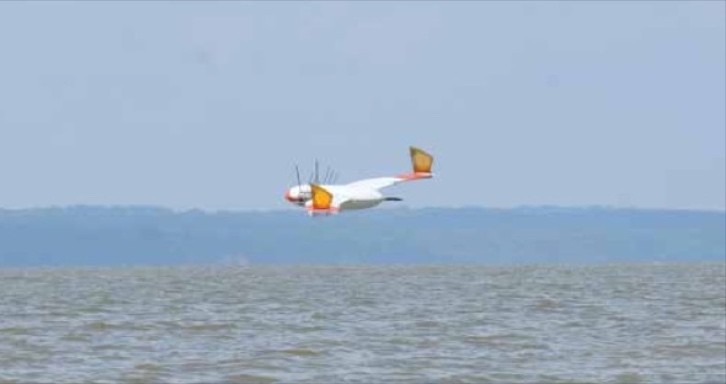You know how flying is a lot more affordable energy-spending wise since air is approximately 1,000 times less dense than water. It means the power required to overcome drag is substantially reduced while flying. Nevertheless, exploring underwater transport has its obvious advantages. But what if there was a way to have both in just one vehicle that would be unmanned?
We already have a series of amphibious vehicles that perfectly work both on land and in water, why wouldn’t we try to push things even further away after all? Like always, the military is once again a step ahead since the Navy is already working on something like that. Called the Flimmer, which stands for the Flying Swimmer, the program is run by the Naval Research Laboratory (NRL). Their plan is to find a way to provide a novel airborne delivery method for unmanned underwater vehicles (UUVs).
Uuu, so cool. Well, cool and quite hard to figure out since, like we previously said, the drag difference between water and air is huge. Then, there’s also the pressure that pushes onto the craft’s walls once it goes under water.
Yes, but why do they need something like that, you may ask. Well, it’s because flying a submarine over the ocean’s surface into position, transitioning from flight to underwater, and then enabling a swimming mode once underwater could save a lot of time and resources, mainly fuel.
Again, there’s a two-sided problem. While weight is the main enemy of an aircraft designer, thus making lightweight materials imperative for it to be efficient, underwater vehicles are built the opposite way completely. As an underwater vehicle descends, the pressure applied by the water column increases rapidly, requiring the use of a strong pressure vessel to protect the electronics from water.
So the Navy is working on a way to handle the enclosed air volume, which is the main driver of weight for a submarine. For an aircraft to land on the water, its structural elements need to be more robust to survive the high impact of splashdown.
“The Flimmer program adds a further complication into design: flapping fins are used for underwater propulsion. [...] A four-finned configuration provides high maneuverability and good stability underwater. In air, however, the fins add weight and are relatively fragile mechanisms that need to be able to survive the forces of splashdown. Bringing all these design elements together is the central challenge of the Flimmer program,” NRL explains in the winter issue of Spectra, the magazine of the NAVY’s corporate laboratory.
Don’t be surprised if you’ll see these puppies rushing through our world in the near future though.
Uuu, so cool. Well, cool and quite hard to figure out since, like we previously said, the drag difference between water and air is huge. Then, there’s also the pressure that pushes onto the craft’s walls once it goes under water.
Yes, but why do they need something like that, you may ask. Well, it’s because flying a submarine over the ocean’s surface into position, transitioning from flight to underwater, and then enabling a swimming mode once underwater could save a lot of time and resources, mainly fuel.
Again, there’s a two-sided problem. While weight is the main enemy of an aircraft designer, thus making lightweight materials imperative for it to be efficient, underwater vehicles are built the opposite way completely. As an underwater vehicle descends, the pressure applied by the water column increases rapidly, requiring the use of a strong pressure vessel to protect the electronics from water.
So the Navy is working on a way to handle the enclosed air volume, which is the main driver of weight for a submarine. For an aircraft to land on the water, its structural elements need to be more robust to survive the high impact of splashdown.
“The Flimmer program adds a further complication into design: flapping fins are used for underwater propulsion. [...] A four-finned configuration provides high maneuverability and good stability underwater. In air, however, the fins add weight and are relatively fragile mechanisms that need to be able to survive the forces of splashdown. Bringing all these design elements together is the central challenge of the Flimmer program,” NRL explains in the winter issue of Spectra, the magazine of the NAVY’s corporate laboratory.
It will get faster, stronger, better
Tests have been running for some time now, and the latest version of Flimmer the Navy is “playing” with is an aerodynamic fish called the Flying WANDA. The name comes from the Navy’s fish-mimicking “Wrasse-inspired Agile Near-shore Deformable-fin Atuomaton.” In tests, WANDA could reach speeds of up to 57 mph while flying, and just 11 miles per hour in the water.Don’t be surprised if you’ll see these puppies rushing through our world in the near future though.
